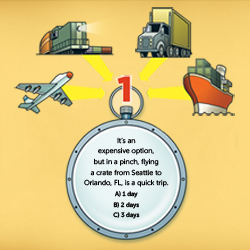|
REGISTRATION REQUIRED
exhibiting 101
 image: Marcos Mesa Sam Wordley/shutterstock.com
Worst-Case Scenarios
There are greater misfortunes facing your exhibit than errant shipping crates. Here are tips to help you handle widescale trade show disasters.
Most experienced exhibit and event managers have a Plan B for common calamities, such as an exhibit that's lost in transit, a damaged graphic, or a key staffer falling ill. But have you ever considered the unexpected on a grander scale – think natural and unnatural disasters along the lines of hurricanes, floods, and terrorist attacks – that can derail an entire trade show? I hate to be the bearer of bad news, but any number of situations can arise that put your exhibiting program and, more importantly, you and your staffers in jeopardy.
And if you think show management has a plan in place to handle large-scale disasters, think again. I did an informal survey of show managers, and based on their input, I don't believe that many of them have any more of a risk-management plan ready than the majority of exhibitors do. They've abdicated that responsibility to either the venue itself or their general services contractor, and those folks seem very secretive about their emergency plans when asked. Since managing a major disaster will likely fall on your shoulders, let's look at some of the worst-case situations that have befallen trade shows and what we can take away from others' hard-learned experiences. Let it Snow The old saying "The show must go on" may or may not ring true when it comes to snow emergencies. During a statewide travel ban caused by a blizzard about to hit Boston in 2015, Yankee Dental Congress' show management team did a fantastic job of coordinating an expedited setup before the brunt of the storm hit by using social media to keep exhibitors and attendees in the loop. However, the following year a massive blizzard hit the entire East Coast with a wallop and shut down the Walter E. Washington Convention Center in Washington, D.C., delaying the opening of the Washington Auto Show by four days. Takeaway Tips: ➤ Contact show management to find out how it will communicate special advisories regarding potential changes to the show schedule. ➤ Read your booth space rental contract to find out what rights you have in case of weather-related delays and cancellations based on force majeure, a contractual clause that releases both parties from liability in the event of an act of God or circumstances beyond either party's control. ➤ Know what kind of insurance your company has against natural disasters and if any of your exhibit property or opportunity costs are covered. Up in Smoke Perhaps the most devastating trade show fire was the one that completely destroyed Chicago's McCormick Place in 1967 the day before the National Housewares Manufacturers Association Show, which housed roughly 1,250 booths. With the venue and all its contents destroyed, exhibitors who decided to tough it out were hastily moved to a makeshift show at the Palmer House Hilton Chicago. Thankfully I've never had to cope with such an inferno, but I have had three fires in my exhibits during my 25-year career: one caused by poorly ventilated computers and two resulting from halogen lighting that melted equipment cables and graphics. These blazes certainly rattled me and my staffers, but thankfully quick thinking and action averted disaster. Takeaway Tips:➤ Always keep at least one ABC-rated fire extinguisher in your exhibit and familiarize yourself with how to use it. ➤ Know the location of the venue's nearest fire apparatus and add this info to your staff-training materials. ➤ Inquire about the best way to notify the convention center of a fire, which could be either contacting the venue's management on a house phone or activating the manual fire alarm pull station nearest your booth. ➤ Whenever possible, swap halogen lights for cooler-operating LEDs. ➤ Have adequate ventilation for any lighting or equipment that generates a large amount of heat. ➤ Find out what documentation you need to back up an insurance claim should one be necessary and what the time frame is for filing it. When it Rains, it Pours In 2010, the exhibit hall for the Defense Information Systems Agency (DISA) Customer Partnership Conference at the Gaylord Opryland Resort and Convention Center in Nashville, TN, flooded when torrential rains caused the Cumberland River to overflow its banks. An estimated 350 exhibits were destroyed in up to 16 feet of water, and exhibitors were not even let into the venue to take stock of the damage for about 10 days. I've been spared a flood (knock on wood), but I'm familiar with how damaging rainy weather can be, thanks to my wooden crates once being stored outside the Orange County Convention Center (OCCC) in Orlando, FL, during the summer rains. The crates were soon waterlogged, and their drenched cardboard cartons were reduced to soggy slime. And I had little recourse, since material handling agreements don't specify where or how your goods will be stored. Takeaway Tips:➤ If any of the contents of your crates that go to storage during the show are valuable (including your outbound packing material), make sure the cases are watertight or your contents are protected in plastic. ➤ Consider paying the extra fees to keep your valuable freight containers in the general services contractor's accessible storage, which is generally stored dockside in an enclosed trailer. ➤ In the event of a flood, contact your insurance carrier immediately to find out their requirements for filing a claim, such as shipping manifests and signed statements from the show manager, local authorities, etc. Hurricanes and Tornados Nature's most powerful storms can wreak havoc on everything in their path, including trade shows. Last October, the OCCC closed for three days due to the potentially damaging winds of Hurricane Matthew, which affected five shows and events that either postponed their opening dates or rescheduled entirely. Although extremely rare, inclement weather can turn a trade show into a tragedy. In 1999, the first F2 magnitude tornado ever in Utah made a direct hit on one of the temporary tents housing exhibits at the Outdoor Retailer Show next to the Salt Palace Convention Center. One person was killed and approximately another 100 were injured. The area around the pavilions was quarantined, but exhibitors with booths inside the Salt Palace pulled together to share space with those who lost their exhibits. Takeaway Tips:➤ Hurricanes are often forecast well in advance, but their potential impact on a venue and the surrounding area is less certain. Stay tuned to the venue management's updates. ➤ Tornados can strike with much less warning. If a tornado warning is called, ask that staffers remain in the exhibit. Venue management will initiate emergency procedures if necessary ➤ Have communication protocols in place so you and your staffers know how to reach each other in the event of an emergency situation. Infectious Diseases Trade shows can also be derailed by the most microscopic of threats. We've seen numerous widespread outbreaks of disease over the past few decades, including Ebola, avian (bird) influenza, severe acute respiratory syndrome (SARS), and, most recently, the Zika virus. The financial repercussions of such outbreaks can extend beyond your company's trade shows. The Conference Board of Canada estimates that the 2003 SARS outbreak in Toronto cost the city almost $1 billion in gross domestic product and about $350 million in tourism-related losses. Takeaway Tips: ➤ Stay informed about health emergencies using government websites, which can alert you to public-health incidents and risk-management steps. ➤ Educate staffers about appropriate precautions while traveling and at shows, including self-isolation and quarantine if they feel they are coming down with something. ➤ Take preventative measures like having antibacterial hand sanitizer and offering immune-boosters such as Vitamin C lozenges to your staff. Terrorism and Violence Luckily, no trade show has been the direct target of a terrorist attack. However, the Boston Marathon bombing in 2013 did result in the immediate evacuation and closure of the John B. Hynes Veterans Memorial Convention Center just three blocks away, which halted the move-out of one show and delayed the setup of another. Takeaway Tips: ➤ Be aware of a venue's emergency exits and share their location with your exhibiting team. ➤ Establish an official means of communication with staffers during and after an emergency, whether through cellphones, text messages, or email. ➤ Designate a location outside the venue where team members can regroup after an emergency evacuation. There is no "one size fits all" way to manage threats, but developing an emergency contingency plan and sharing with your team can enable everyone to respond appropriately when the unthinkable occurs. E  Candy Adams
Candy AdamsCTSM, CEM, CMP, CMM "The Booth Mom," is an independent exhibit project manager, trainer, speaker, consultant, and an Exhibitor Conference faculty member. CandyAdams@BoothMom.com
|
|
|
||||||||||||||||||||||||||||
|
|
||||||||||||||||||||||||||||
|
TOPICS Measurement & Budgeting Planning & Execution Marketing & Promotion Events & Venues Personal & Career Exhibits & Experiences International Exhibiting Resources for Rookies Research & Resources |
MAGAZINE Subscribe Today! Renew Subscription Update Address Digital Downloads Newsletters Advertise |
FIND IT Exhibit Producers Products & Services All Companies Get Listed |
EXHIBITORLIVE Sessions Exhibit Hall Exhibit at the Show Registration |
ETRAK Sessions Certification F.A.Q. Registration |
EDUCATION WEEK Overview Sessions Hotel Registration |
CERTIFICATION The Program Steps to Certification Faculty and Staff Enroll in CTSM Submit Quiz Answers My CTSM |
AWARDS Exhibit Design Awards Portable/Modular Awards Corporate Event Awards Centers of Excellence |
NEWS Associations/Press Awards Company News International New Products People Shows & Events Venues & Destinations EXHIBITOR News |
||||||||||||||||||||
|
||||||||||||||||||||||||||||






